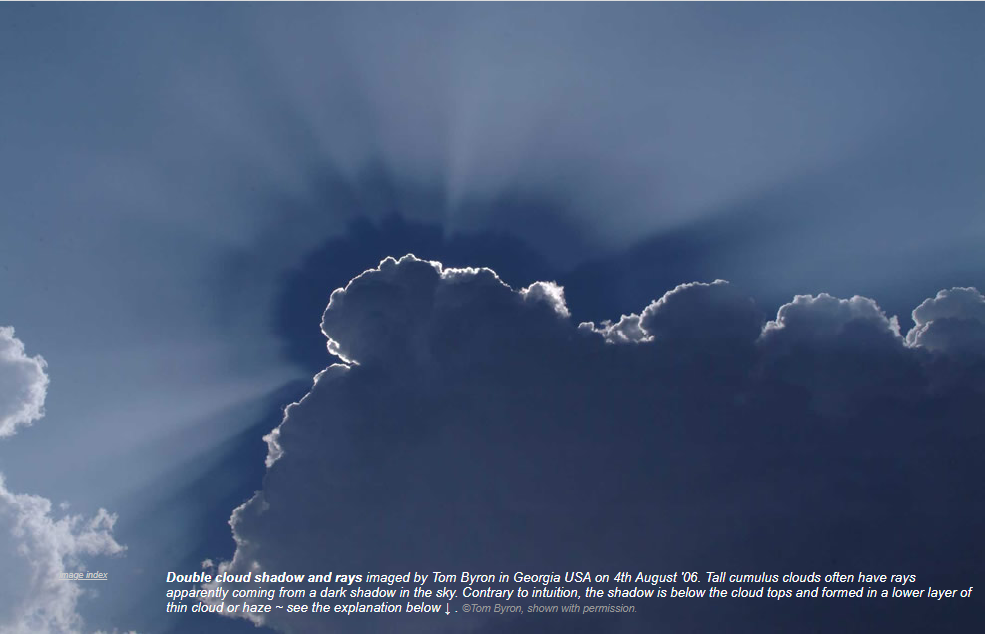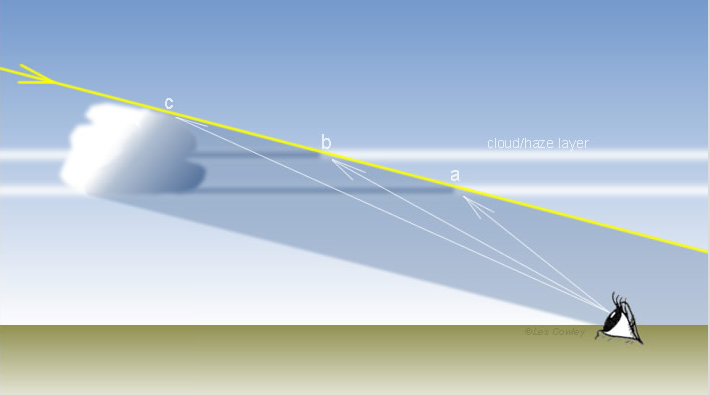Rays & Double Cloud Shadow
Rays & Double Cloud Shadow: A Fascinating Atmospheric Phenomenon
When gazing up at the sky, we are often treated to mesmerizing displays of light and shadow. One particularly captivating atmospheric phenomenon is the occurrence of rays and double cloud shadows. These ethereal spectacles can be observed when tall cumulus clouds cast their shadows onto lower layers of haze or cloud. Contrary to intuition, the shadow appears below the cloud tops, forming in a lower layer of thin cloud or haze. In this article, we will delve deeper into the intricacies of rays and double cloud shadows, unraveling the science behind their formation and exploring the visual effects they create.
The Formation of Double Cloud Shadows
To understand the formation of double cloud shadows, we must first grasp the concept of how clouds cast their shadows onto lower layers of haze or cloud. When sunlight interacts with a cloud, the cloud absorbs and scatters some of the light, resulting in a shadow being cast on the layers beneath it. However, what makes double cloud shadows intriguing is that they appear to originate from a dark shadow in the sky, seemingly defying our intuition.
In reality, the dark shadow that gives rise to the rays is formed in a lower layer of thin cloud or haze. The top edge of this shadow, on the uppermost layer, creates the illusion that it is higher in the sky than the actual cloud top. This optical effect is due to the perspective from which we observe the phenomenon.
The Appearance of Rays and Double Cloud Shadows
When observing rays and double cloud shadows from the ground, they often appear as if they are emanating from a central point, fanning outwards like beams of light. This visual effect is known as crepuscular rays. However, despite their apparent divergence, these rays are actually parallel irregularities at the edges of the cloud's shadow tube.
The interaction between sunlight and atmospheric particles plays a crucial role in the formation of crepuscular rays. As sunlight passes through gaps in the cloud or haze layer, it scatters off the particles, creating a cone of light that appears to radiate from the position of the sun. The convergence of these scattered rays produces the captivating fan-like pattern we observe.
Factors Influencing the Intensity of Double Cloud Shadows
The intensity of double cloud shadows and rays can vary depending on several factors. Some of the key factors that influence their appearance include:
-
Cloud Thickness: The thickness of the cloud layer impacts the amount of sunlight it absorbs and scatters. Thicker clouds tend to cast more defined and prominent shadows, enhancing the visual impact of the phenomenon.
-
Atmospheric Conditions: The presence of additional layers of haze or cloud beneath the casting cloud can amplify the contrast between the shadow and the surrounding sky. This can result in a more pronounced double cloud shadow effect.
-
Sun's Position: The angle at which sunlight interacts with the cloud and its subsequent shadow plays a role in determining the appearance of rays. The lower the sun is in the sky, the longer and more pronounced the rays tend to be.
Similar Atmospheric Optics Phenomena
Rays and double cloud shadows are just a few examples of the awe-inspiring atmospheric optics phenomena that grace our skies. Here are some other fascinating occurrences that share similarities with this phenomenon:
-
Anticrepuscular Rays: These rays are essentially the opposite of crepuscular rays. They appear to converge towards the point opposite to the sun's position in the sky, creating a striking visual effect.
-
Brocken Spectre: This optical illusion occurs when an observer's shadow is cast onto clouds or fog below them. The shadow appears magnified and surrounded by a halo, often accompanied by colorful rings known as glory.
-
Iridescent Clouds: These vibrant and iridescent clouds are a result of diffraction, which causes sunlight to be scattered by tiny water droplets or ice crystals in the cloud. The diffraction produces a stunning display of colors within the cloud.
Capturing the Beauty of Rays and Double Cloud Shadows
For photographers and sky enthusiasts, capturing the mesmerizing beauty of rays and double cloud shadows can be a rewarding endeavor. To best capture these phenomena, consider the following tips:
-
Timing: The optimal time to observe rays and double cloud shadows is during sunrise or sunset when the sun is at a lower angle in the sky. This angle accentuates the length and intensity of the rays, creating a more captivating visual spectacle.
-
Composition: Look for interesting foreground elements to complement the rays and double cloud shadows. Trees, buildings, or other objects can add depth and context to your photographs, enhancing their overall impact.
-
Exposure: Experiment with different exposure settings to capture the subtle nuances of light and shadow. Bracketing your shots can help ensure you capture the full dynamic range of the scene.
In conclusion, rays and double cloud shadows are a captivating atmospheric phenomenon that never fails to mesmerize those fortunate enough to witness them. Understanding the science behind their formation and the visual effects they create adds an extra layer of appreciation for the beauty of our natural world. So, next time you find yourself gazing up at the sky, keep an eye out for these enchanting displays of light and shadow, and marvel at the wonders of atmospheric optics.

Double cloud shadow and rays imaged by Tom Byron in Georgia USA on 4th August '06. Tall cumulus clouds often have rays apparently coming from a dark shadow in the sky. Contrary to intuition, the shadow is below the cloud tops and formed in a lower layer of thin cloud or haze ~ see the explanation below ↓ . ©Tom Byron, shown with permission.


Cloud shadows in the air and on haze layers. The cloud casts its shadow more strongly onto lower layers of haze or cloud which then appear dark to an observer beneath them. The sun's rays (yello) always shine downwards. The top edge of the cloud is in direction :c:. The top of the shadow on the uppermost layer is in direction "b" which to the 'eye' looks higher in the sky than the cloud top. The diagram at left shows the appearance from the sky. the crepuscular rays appear, by perscpective, to fan out from the position of the sun but in fact they are all parallel irregularities at the edges of the cloud's shadow tube.
Note: this article has been automatically converted from the old site and may not appear as intended. You can find the original article here.
Reference Atmospheric Optics
If you use any of the definitions, information, or data presented on Atmospheric Optics, please copy the link or reference below to properly credit us as the reference source. Thank you!
-
<a href="https://atoptics.co.uk/blog/rays-double-cloud-shadow/">Rays & Double Cloud Shadow </a>
-
"Rays & Double Cloud Shadow ". Atmospheric Optics. Accessed on December 22, 2024. https://atoptics.co.uk/blog/rays-double-cloud-shadow/.
-
"Rays & Double Cloud Shadow ". Atmospheric Optics, https://atoptics.co.uk/blog/rays-double-cloud-shadow/. Accessed 22 December, 2024
-
Rays & Double Cloud Shadow . Atmospheric Optics. Retrieved from https://atoptics.co.uk/blog/rays-double-cloud-shadow/.